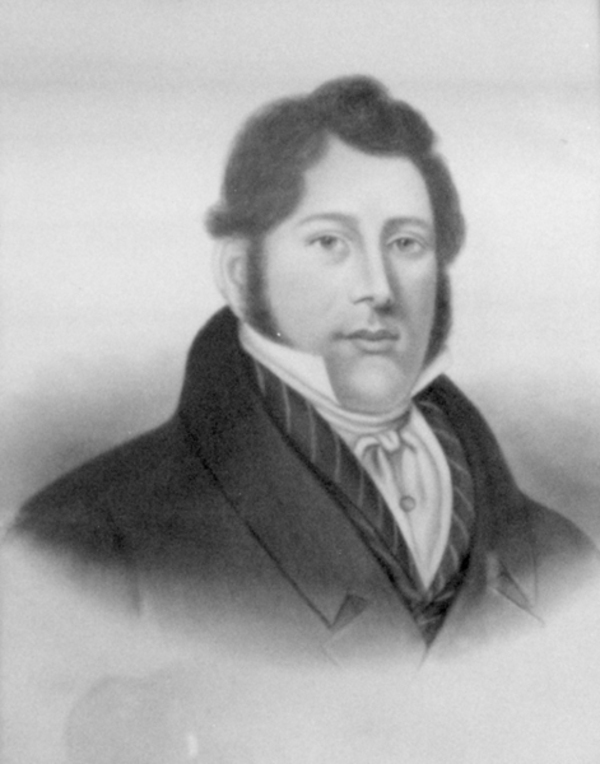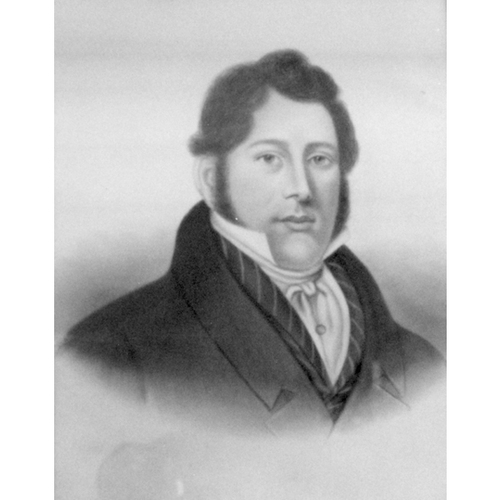
Source: Courtesy of Wikimedia Commons
DAVIE, ALLISON, sea captain and shipbuilder; b. 4 May 1796 and baptized privately the next day at Great Yarmouth, England, son of Captain Allison Davie (who was buried in 1818 at Gorleston, near Great Yarmouth) and Elizabeth Cock; drowned June 1836 between Quebec and Pointe-Lévy (Lauzon and Lévis), Lower Canada.
Allison Davie came from an old English family that can be traced back to 1603, when William Davie lived in Stanfield, Norfolk County. Allison was the eldest of four boys and several girls. During the Napoleonic Wars, while still young, he entered the service of the East India Company and took part in transporting British troops in the Mediterranean.
It was on a trip to Quebec in 1825 that Davie met Elizabeth Johnson Taylor, only daughter of George Taylor, a shipbuilder, and his wife Elizabeth Taylor. Born in 1803 at North Shields, England, she had left her native land aboard the Three Brothers with her parents on 27 May 1811 and reached Quebec on 9 August. Her father had immediately opened a shipyard on the southwest shore of the Île d’Orléans at a place known as St Patrick’s Hole. Because of the war with the United States, however, Taylor had to suspend his activities in December 1812 and go with other sailors and carpenters to build ships in Upper Canada. On returning to Île d’Orléans after hostilities ended, he resumed operations. Taylor’s yard was prospering when Davie, a 300-pound “giant” with an excellent reputation as a sea captain, landed at Quebec and fell in love with Elizabeth. Taylor agreed to his daughter’s marriage with Davie on two conditions: that he abandon sailing and settle down as heir to the Taylor business, and that he give his children the Taylor name. Davie assented, and the marriage was performed by the Reverend James Harkness on 16 April 1825, according to the records of St Andrew’s Presbyterian Church at Quebec.
On 14 May 1827 the Taylor enterprise, in which Davie was a partner, launched the King Fisher, a 221-ton brig with 16 guns built for the colonial government. The launching was a major event of the day, and among the many guests at the ceremony was Governor Lord Dalhousie [Ramsay]. Dalhousie presented Taylor with a silver cup engraved with the governor’s coat of arms surmounted by a unicorn, the ship’s figurehead, which had been executed by silversmith Laurent Amiot. Shortly afterwards the yard on Île d’Orléans was shut down.
On 2 Dec. 1829 Davie bought a waterfront property at the foot of the cliff at Pointe-Lévy on the south shore of the St Lawrence with a view to setting up his enterprise there. He purchased another site on 28 December of the following year. On these lots he put up the facilities needed for repairing ships. But, as the Quebec Gazette reported on 5 March 1832, during the violent spring break-up “the large wharf” of his shipyard, “after being thrown over by the ice, was carried down the river.” Undaunted by the disaster, Davie started over again with such energy that by autumn he had the Pointe Levis Patent Slip back in operation.
Of all the qualities that contemporaries recognized in Davie, ingenuity was the one most stressed. For example, according to the Quebec Gazette of 29 Oct. 1832, he was the first person in the Canadas to employ a system invented in England that allowed ships to be repaired without being put into dry dock. For this purpose he had an inclined marine railway built. The vessels, “taken at high water,” were hauled out of the river on a cradle “moving on iron rollers and being drawn up by an iron chain.” “We believe this is the first establishment of the kind formed in British America,” the newspaper added.
The ingenious Captain Davie was not destined, however, to live long after this achievement. “One evening in the month of June 1836,” Joseph-Edmond Roy* recounts, “as he was moving in a rowboat past a ship anchored in mid stream, the captain of the ship threw him a package, which fell into the sea instead of into the rowboat.” In leaning overboard to catch the package Davie fell in himself. He went under and did not come up. Le Canadien reported on 20 June that his body, with “his gold watch, some money, and the keys he had on him,” had been found at Saint-Pierre, Île d’Orléans, the preceding afternoon, “a few days” after the accident “in the roads.”
Elizabeth Davie, widowed with nine children at age 33, took charge of the business in order to safeguard the family’s inheritance. The first woman to head a shipbuilding firm in Canada, she ran the yard and soon made a reputation for herself as a talented builder with a keen eye for the trees to be cut. On occasion she sought help from her father, who had retired but lived until 1861. Around 1850 she handed the running of the company over to her eldest son, George Taylor Davie*, who had apprenticed in John Munn*’s shipyards in the faubourg Saint-Roch at Quebec. He gradually bought up his brothers’ and sisters’ shares, with the result that on 28 May 1885 all of Allison Davie’s heirs declared him sole owner of the family business. Elizabeth Davie had died in 1873, at age 70. Thanks to George’s business sense and professional skill, the operation prospered and grew through the purchase of a site at Saint-Joseph (at Lauzon), where he founded the Davie Shipbuilding and Repairing Company Limited.
Despite his short and modest career Allison Davie had laid the foundation of an enterprise which, through his successors, won an enviable place in the shipbuilding field.
ANQ-Q, CE1-66, 16 avril 1825. MIL Davie Inc. Arch. (Lauzon, Que.), “A shipbuilding dynasty,” ed. E. R. Axelson, Canada’s shipyards (photocopy); “Davie Shipbuilding Limited, Lauzon, P.Q.” (typescript); “Shipbuilding industry in our district” (photocopy). Norfolk Record Office (Norwich, Eng.), Great Yarmouth, reg. of baptisms, 4–5 May 1796. Parish arch., Gorleston with South Town (Gorleston, Eng.), reg. of burials, 24 Dec. 1818. Le Canadien, 20 juin 1836. Quebec Gazette, 14 May, 20 Aug. 1827; 5 March, 29 Oct. 1832. P.-G. Roy, Dates lévisiennes (12v., Lévis, Qué., 1932–40), 1: 77, 101, 130–31, 177, 256, 318; 2: 17; 3: 165; 5: 257–58; 7: 259. George Gale, Historic tales of old Quebec (Quebec, 1923), 145. G. W. Haws, The Haws family and their seafaring kin (Dunfermline, Scot., 1932), 150–59. J.-E. Roy, Hist. de Lauzon, 5: 162–64. P.-G. Roy, Glanures lévisiennes (4v., Lévis, 1920–22), 1: 33–35; Profils lévisiens (2 sér., Lévis, 1948), 2: 74–75. “Historique du chantier,” L’Écho maritime (s.1.), février 1945. Denis Masse, “Québec, berceau de l’industrie de la construction maritime au Canada,” Le Soleil (Québec), 2 nov. 1957: 40, 42. “Naissance de la Davie: tout commence par un mariage,” Canada Steamship Lines, Le Monde (s. 1.), 2 (1976), no.3: 8.
Cite This Article
Diane Saint-Pierre, “DAVIE, ALLISON,” in Dictionary of Canadian Biography, vol. 7, University of Toronto/Université Laval, 2003–, accessed April 12, 2025, https://www.biographi.ca/en/bio/davie_allison_7E.html.
The citation above shows the format for footnotes and endnotes according to the Chicago manual of style (16th edition). Information to be used in other citation formats:
| Permalink: | https://www.biographi.ca/en/bio/davie_allison_7E.html |
| Author of Article: | Diane Saint-Pierre |
| Title of Article: | DAVIE, ALLISON |
| Publication Name: | Dictionary of Canadian Biography, vol. 7 |
| Publisher: | University of Toronto/Université Laval |
| Year of revision: | 1988 |
| Access Date: | April 12, 2025 |



